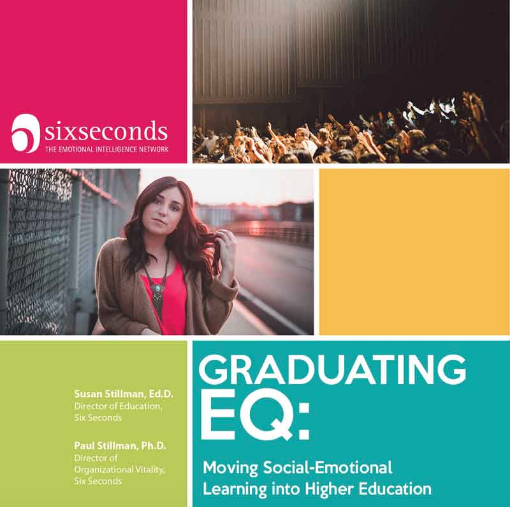How do we bridge the gap between childhood and the workforce? What exists between those worlds? Higher Education needs emotional intelligence like all school settings. So how does EQ fit into the Higher Ed?
EQ in schools has measurable success. There is a large and growing body of research that shows that understanding and being sensitive to emotions leads to healthier relationships, greater self-awareness, and other essential traits that make for successful adults. It has also become clear that EQ is important in the working world. Companies are now increasingly interested in hiring employees with high EQ as they tend to be more productive, better at handling pressure, and working well with others.
Recently educators, administrators, students & researchers from 89 countries joined in the first ever virtual conference on emotional intelligence in higher education called EQ.EDU: Moving SEL into Higher Ed. Here’s what participants learned about the value of EQ beyond the k-12 educational setting.
Today, many university students are facing challenges that they are emotionally unfit to handle. Students often leave university due to dejection, disillusionment, or apathy as opposed to low ability. Drop-out rates are exceptionally high and though more than 2 million students begin college in the US each year, only about half will leave with a diploma. Now more than ever it is essential that students possess the proper emotional skills that will allow them to succeed in school.
College can be a demanding place for students and faculty alike. Feelings of isolation and a lack of community are not uncommon and these issues are becoming more present with the expansion of online learning.
What if we could use EQ to create an environment of collaboration and empathy within higher education?
In the first EQ in Higher Education virtual conference, EQ.EDU Moving SEL into Higher ED organized by Six Seconds Director of Education, Dr. Susan Stillman and Assistant Director of Education, Cherilyn Leet, experts in higher education gathered to offer their expertise on increasing connection and building communities in the higher education landscape.
What role does EQ play in higher education?
- Social-emotional learning can promote engaged communities in higher education
- EQ can lessen the impact of the challenges that students and faculty face on campus
- We use emotional intelligence to foster trusting, engaged, supportive groups among students, faculty & staff, and virtual teams


Many students who enter higher education end up leaving without a degree, or if they stay, they fail to succeed.
While some may lack the critical thinking and study skills necessary to academically flourish, many others are emotionally ill-equipped and do not possess the grit needed to thrive. According to a study conducted by Harris Poll for The JED Foundation, Partnership for Drug-Free Kids, and The Jordan Porco Foundation 60 percent of college students said they wished they had “more help getting emotionally ready for college.”
Emotional preparedness was a major factor in determining whether a student had a successful freshman year or not.
According to Dr. Sue McNamara, Six Seconds’ Regional Network Director and Adjunct Professor and Programme Lead of Soft Skills with the Institute for Engineering Leaders at the National University of Singapore, universities should begin with the end in mind. What will success at their institution look like and what will it require? EQ is an essential factor in developing the social and academic skills needed for success in higher education and Dr. Sue McNamara notes that the implementation of EQ in higher education results in less conflict, better decisions, deeper relationships, and more collaboration.
According to the student panel present at EQ.EDU Moving SEL into Higher ED, EQ skills, such as the ability to sit with new and uncomfortable ideas, are vital for developing a global mindset and for collaborating with diverse peers.
While EQ skills help students learn teamwork and leadership abilities, it is also important for faculty and staff to be involved. Faculty should guide students in the process of re-defining education with the inclusion of EQ development, and universities should work on creating spaces for students to “feel” a part of the community.
How can EQ competencies help educators themselves?

Many educational leaders around the world believe that EQ skills are critical for helping college and graduate students, young and old, to succeed. But can these skills can be just as beneficial for educators?
Developing EQ competencies can help faculty become more effective leaders, teachers, and colleagues and can help fight stressors such as disengagement, burnout, and challenging student issues.
According to the faculty panel present, university leadership should promote events and create opportunities for faculty to deepen their EQ. Navigating the field of higher education is challenging and the cultural competence of the faculty is critical for the community’s success.

Dr. Jensen, an EQ Pioneer, President of Six Seconds, and Professor at Notre Dame de Namur University, believes that emotional intelligence can deepen a university’s community. The current and future success of any college campus centers on the strengths of its people and communities – and what better a way to grow those strengths than with EQ?
When colleges develop their community’s emotional intelligence, diversity, equity, and inclusion prosper – critical values for any college committed to social justice.
Dr. Jensen believes that every interaction leaves an exchange of emotions and that emotions are more contagious than the common cold, which begs the question: What trace emotion will you leave in your interactions with students and colleagues?
What’s new in emotional intelligence?
What Should Schools Prepare Us For? Educating for a Future That Inspires and Uplifts
In Italy, only 5% of workers are engaged in their jobs—an economic crisis with deep roots in the education system. What needs to change?
Fortifying the Mental Health of the Entire School Community with Emotional Intelligence
Wellbeing program at St. Peter’s Primary replenishes reserves post-COVID: ‘Truly life changing for many of our staff,’ school leaders say. Read the full case study here.
Productive Struggle: 4 Neuroscience-Based Strategies to Optimize Learning: EQ Education News
Do you instinctively want to help students when they’re struggling? What if some level of struggle was necessary for learning? Brain-based learning researchers have discovered a sweet spot for learning called “productive struggle.” Here’s why and how it works.
Emotion Science from Inside Out 2 – EQ Education News
What do you think and feel about the emotions in Inside Out 2? Let’s unpack the science and how you can use the film to keep developing emotional intelligence skills for you, your faculty and students.
Is Boredom Bad for Kids? Emotional Intelligence Education News
Let’s unpack boredom and how emotional intelligence can help you with tips to support bored children (and keep your cool!). Keep reading for EQ research and resources you can use for you, your faculty and students.
Are you a Maximizer or a Satisficer? Tips for Better Decisions – EQ Education
Overwhelmed by decisions? Here’s how emotional intelligence can help you develop strategies to be more efficient and balanced in your decisions not defeated by them.
- Enhance Emotional Literacy - July 13, 2023
- Plutchik’s Wheel of Emotions: Feelings Wheel - March 13, 2022
- Technology Loneliness: EQ Tips from Daniel Goleman - October 24, 2020








